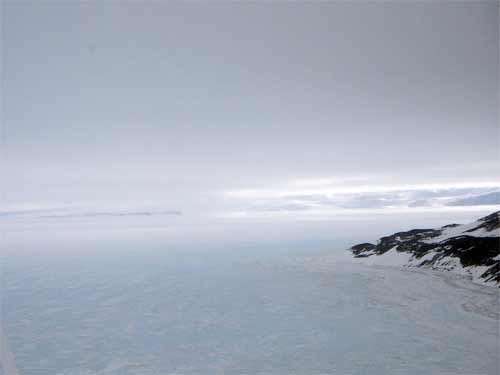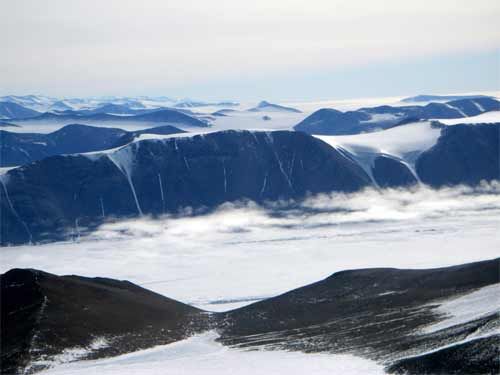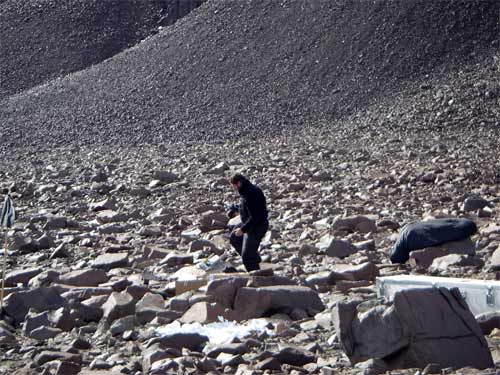Today is the Big Day. Almost one year in the planning with a few twists and turns in the expedition, but I will shortly be in a helicopter beginning the PolarTREC experience in Beacon Valley. In addition to transporting me to Beacon Valley, the helicopter will move the camp from the first location in Mullins Valley to the second drilling location and campsite in Beacon Valley. I did my laundry and took my bags to the helicopter pad. I intended to leave them and return for my 1350 scheduled departure. Instead the pilot asked if I could go early because they were concerned with weather moving in and the other trips had already been canceled. We departed around 1230.
There were many opportunities to take spectacular photographs of Mt. Erebus and several glacial features during the ride to Beacon Valley. Enjoy these scenes captured from the helicopter window.
 The top of Mt. Erebus is visible above the clouds.
The top of Mt. Erebus is visible above the clouds.
 Lots and lots of sea ice.
Lots and lots of sea ice.
 The sea ice is on the left of the photograph and the glacier is on the right.
The sea ice is on the left of the photograph and the glacier is on the right.
 The cloud cover and beauty of Blue Glacier create a surreal landscape.
The cloud cover and beauty of Blue Glacier create a surreal landscape.
 Kukri Hills and the Ferrar Glacier.
Kukri Hills and the Ferrar Glacier.
 Photograph of Taylor Glacier. Notice the ice fall in the right foreground.
Photograph of Taylor Glacier. Notice the ice fall in the right foreground.
 Ferrar Glacier
Ferrar Glacier
 Meltwater lakes
Meltwater lakes
 The linear ridges are drop moraines. Taylor Glacier is on the right.
The linear ridges are drop moraines. Taylor Glacier is on the right.
 Finger Mountain is in the background.
Finger Mountain is in the background.
 The ice beneath the polygons is 8 million years old!
The ice beneath the polygons is 8 million years old!
Dave's team has been in the field for 10 days and has just finished drilling and collecting ice cores at the first sampling location when I arrived. I am so excited to finally meet him in person. I had spoken to him several times on the phone. His picture is on the PolarTREC website and he delivered a lecture to Los Angeles Valley College students on October 15 via videoconferencing, and now here he is up close and personal. But my meeting will have to wait a little longer because Dave is busy capturing and photographing the last cores and preparing for a camp move two hours earlier than he had planned!
 My first meeting with Dave Marchant is in Mullins Valley, Antarctica.
My first meeting with Dave Marchant is in Mullins Valley, Antarctica.
 Dave Marchant photographs ice cores as they are retrieved.
Dave Marchant photographs ice cores as they are retrieved.
 The bubbles in the ice represent trapped gasses that will be sent to various laboratories for analysis.
The bubbles in the ice represent trapped gasses that will be sent to various laboratories for analysis.
We finally do meet and I get a chance to say hello before the camp location is moved from Mullins Valley to Beacon Valley. Dr. Marchant has been studying the ancient buried ice in this area for the last ten years. He is the first to study this area and the leading expert. After talking with him, I realize that there are three components to his research in Antarctica: (1) age dating of the buried ice in Beacon and Mullins Valley which is the current drilling project; (2) the discovery of ancient tundra fossils that indicate a warmer climate in Antarctica; and (3) the Dry Valleys as an analog to Mars. I hope to visit the other research sites with Dr. Marchant if time permits.
Stay tuned for camp pictures and individual profiles of the drilling team.
 The National Science Foundation Helicopter moves the camp from Mullins Valley to Beacon Valley.
The National Science Foundation Helicopter moves the camp from Mullins Valley to Beacon Valley.
